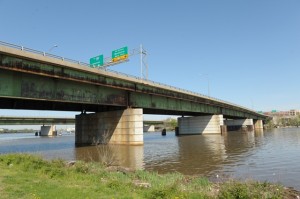Can a Bridge Fix D.C.’s Unemployment Divide?
The divide between communities east and west of the Anacostia River is as tangible as the river itself. So can the way to bridge that divide be as tangible as, well, a bridge?
Enter the 11th Street Bridge Project, a massive $300 million reconstruction effort that will provide a faster connection between Ward 8, where unemployment rates have reached nearly Depression-era levels, and portions of the city with lots of jobs.
U.S. Transportation Secretary Ray LaHood praised the project, saying it’s an example of how public construction puts Americans to work. (So far, 380 have been employed through the project.) Mayor Vincent Gray said the bridge will help chip away at the city’s high unemployment. The bridge jobs themselves aren’t all going to Ward 8 residents, an issue that’s sparked protests, much like ones at St. Elizabeth’s, another Ward 8 redevelopment project. But even if redevelopment construction jobs go to people in affected neighborhoods, they aren’t a permanent solution to high unemployment.
One way to address high and uneven unemployment is improving transit options. As it stands now, getting across the Anacostia River to where most of the city’s jobs are located can be a long or costly undertaking, and there are some fixes in the works. DC Circulator, a cheap and quick way to get around, will start running buses across the Anacostia in October. Bike advocates are encouraging residents to explore cycling as a low-cost and more reliable way to commute. And despite past low usage, Capital Bikeshare has installed more stations in Wards 7 and 8 to improve access. And then there’s the 11th Street Bridge.
But a bridge alone won’t be enough to cross D.C.’s unemployment divide. Experts say better job training programs and education are also needed. It’s just that improving those things is more complicated and time consuming than building a bridge.





